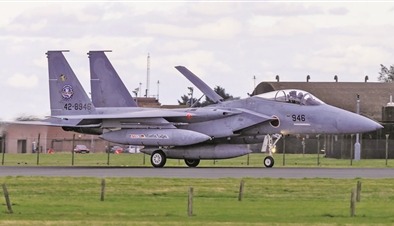
File photo: A Japan Air Self-Defense Force F-15J fighter jet lands at the Royal Air Force Coningsby in the UK.
Recently, Japan and the UK have increased the frequency of their defense interactions and expanded the scope of their cooperation. Analysts believe that the warming of Japan-UK defense ties is a chain reaction triggered by NATO's Indo-Pacificization strategy and the trend toward a more outward-looking Japan Self-Defense Force. However, due to multiple constraints, the cooperation between the two sides appears to be more about posturing than achieving substantive results.
Multiple Areas of Cooperation
Recently, the Japan Air Self-Defense Force completed its first-ever intercontinental deployment operation, codenamed Atlantic Eagle, dispatching fighter jets to Europe. This mission was a key topic during talks between Japanese Defense Minister Gen Nakatani and UK Defense Minister John Healey held in Tokyo at the end of August. The two sides explicitly expressed their intention to further strengthen defense capability building and security cooperation. Before this, Japan and the UK had already launched maritime cooperation. In August, the Royal Navy's aircraft carrier HMS Prince of Wales carrier strike group made a port call at Yokosuka, Japan, and conducted joint exercises with the Japanese side. Subsequently, the Japan Maritime Self-Defense Force destroyer JS Akebono (DD-108) joined the British carrier strike group for deployment in the far seas. Regarding bilateral maritime cooperation, UK First Sea Lord Admiral Sir Gwyn Jenkins stated that naval interactions between the UK and Japan would become closer and more detailed, with plans to establish a reciprocal aircraft carrier visit mechanism. While defense collaboration continues to advance, cooperation between Japan and the UK in the defense industry is also deepening in parallel. In the space sector, Japanese and British companies have reached cooperation agreements to build a satellite constellation system primarily aimed at collecting surface intelligence. In the unmanned systems field, a British drone development company has been actively promoting small unmanned aerial vehicles to relevant departments of the Japan Self-Defense Forces. In the fighter jet domain, both countries have pledged to accelerate the development of their next-generation fighter program (GCAP). In the underwater equipment sector, the two sides plan to explore potential cooperation on underwater technologies within the framework of the AUKUS security alliance.
Each Side with its Own Calculations
The growing military closeness between the UK and Japan essentially reflects a relationship of mutual convenience driven by their respective national interests.
For the UK, strengthening ties with Japan allows it to play a more active role in Indo-Pacific affairs. As a key US ally in the region, Japan possesses a well-developed network of airports, ports, and logistical facilities that can help reduce the operational costs of the UK in expanding its military presence there.
For Japan, closer cooperation with external partners serves as a means to gradually advance its goal of achieving the so-called national normalization. In recent years, Japan's growing tendency to break through the constraints of the pacifist constitution has met strong resistance from domestic peace advocates. To counter such opposition, Japan seeks to bring in extra-regional powers such as the UK to participate in Indo-Pacific affairs, thereby creating a so-called internationally mainstream narrative to legitimize its actions. At the same time, Japan aims to enhance its combat readiness and long-range power projection capabilities through joint tactical training. Some Japanese think tanks argue that cooperation with the UK could help Japan integrate into NATO's military cooperation framework and gradually reduce its overreliance on the US.
Insufficient Cohesion in Bilateral Cooperation
The depth of defense cooperation between Japan and the UK remains limited due to inherent constraints arising from differences in geostrategic focus, disparities in capabilities, and divergent core interests.
The UK's defense priorities are centered mainly on Europe and the Atlantic region, while Japan focuses on East Asia and the Western Pacific. Such strategic divergence leaves both sides with little incentive to commit substantial resources to areas outside their respective spheres of core interest. As a result, joint military exercises and related activities between the two countries tend to serve more as symbolic or episodic demonstrations rather than sustained, institutionalized cooperation.
The composition of the UK's HMS Prince of Wales carrier strike group, augmented by warships from multiple allied navies, also underscores the current shortfall in the Royal Navy's independent force projection capability. The Japan Maritime Self-Defense Force, lacking an independent operational command system, finds it difficult to assume a leading role in high-end tactical coordination. The inherent capability gaps on both sides further exacerbate contradictions in bilateral cooperation. Due to differing regional security positions, the UK maintains only limited support for Japan's outward military development and remains reluctant to become deeply involved in Tokyo's territorial or strategic disputes with neighboring countries. For its part, Japan is also unable to provide substantial assistance to Britain's pursuit of global influence. In the short term, therefore, Japan–UK defense cooperation is likely to remain more demonstrative than substantive.



